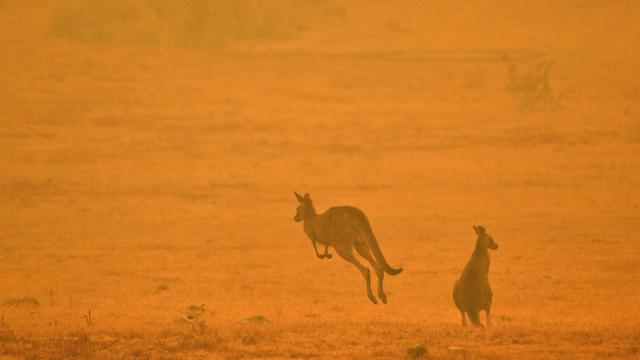Australia’s bushfires have no shortage of horror stats. The blazes have burned 10.6 million hectares. The smoke has travelled more than 11,200 kilometres. They were sparked following Australia’s hottest year ever recorded.
But there’s perhaps nothing more shocking than the number of animals afflicted by the flames. A staggering 1.25 billion animals may have perished in the fires according to estimates by University of New South Wales ecologist Chris Dickman and World Wildlife Fund (WWF), Australia. The losses mean Australia’s forests may never be the same, and they show that climate change is a form of violence on the natural world.
The concept of a billion anything is a tough one to wrap your head around, let alone applied to kangaroos, koalas, wombats, wallabies, snakes, and other creatures that are now dead or dying. Yet here we are, living in that world. The estimate was made using a methodology developed by Dickman and others in a 2007 report for WWF, Australia that found for every 650,000 hectares of Australian land cleared, 104 million animals would perish.
Applied to the fires, the model shows a level of carnage nearly unheard of in the natural world over such a short period of time. While numerous animals have died in the flames, others that survived could be living with injuries that will eventually kill them. Or they could die from lack of food and water in the now-burned out forests. And a news release from the University of New South Wales notes the methodology yields an estimate that’s conservative and doesn’t include insects, frogs, or bats.
Beyond the huge number, there have been stories of heroism and tragedy as Australians have raced to protect nature from the ravages of a climate change-induced catastrophe. People have been scooping wildlife suffering from dehydration and burns from roadsides and caring for them as best they can. Dogs have been sent in search of animals still alive amidst the burned-out forests. People from around the world have also kicked in more than $8 million to help the Port Macquarie Koala Hospital care for injured marsupials.
And yet for all the feel-good stories, there are still tragic ones such as the koala whose rescue went viral that eventually third of the island burned.
Daniella Teixeira, a University of Queensland researcher studying the Kangaroo Island’s cockatoos, told the Guardian that “key feeding and breeding areas” have been destroyed. An estimate in late December noted that New South Wales has lost nearly 30 per cent of its koala population.
What comes next for Australia once the fires are finally extinguished is highly uncertain. The fires are occurring in an ecosystem described by ecologists as Mediterranean due to the semi-arid nature. California, South Africa, Portugal, and Spain are other Mediterranean forest locations, and fires have ravaged them more in recent years as climate change heats things up and dries them out further.
Last year’s bombshell extinction report notes that predicting the effect of fires, habitat fragmentation, water depletion, and other human-driven ills on these types of forests are “difficult to predict” and that increasing fires are modifying “the composition of the vegetation (from coniferous forests to landscapes dominated by broadleaf trees, scrub and grasslands) and decreas[ing] its further resilience to fires.” That means forests will have a harder time bouncing back as will the animals that depend on them for sustenance and protection. It’s no wonder the report came to the conclusion that up to a million species are at risk of extinction.
Indeed, the skyrocketing death toll of the wildfires is a huge blow to not just Australia’s wildlife but the world’s biodiversity. Owing to the country’s isolation, there are boatloads of species there that are found nowhere else in the world. While the megafauna like kangaroos and medium-fauna (pretty sure that’s a real thing, right?) like koalas have attracted the most attention, other species are at risk of being lost forever. And the world will be poorer for it.
